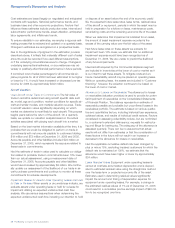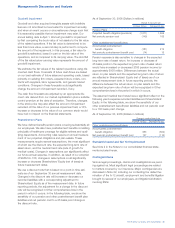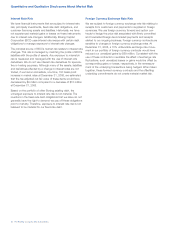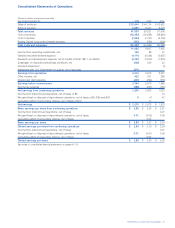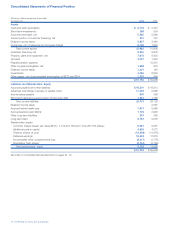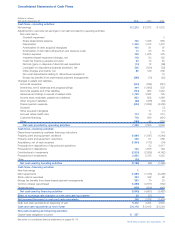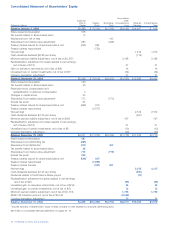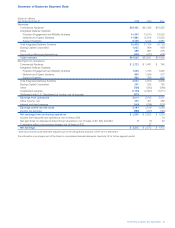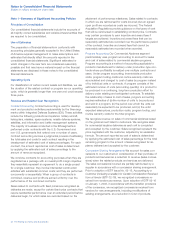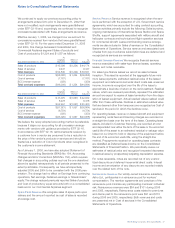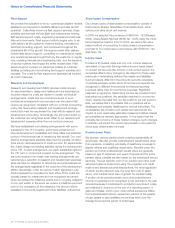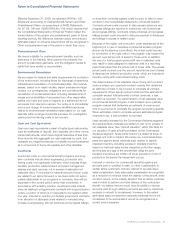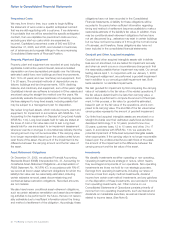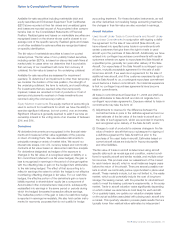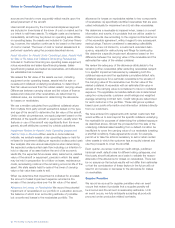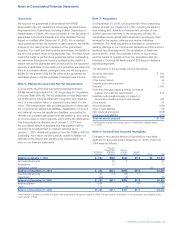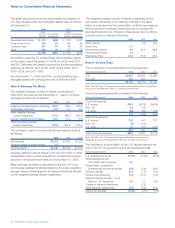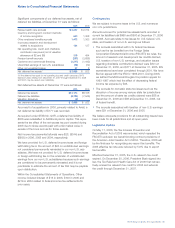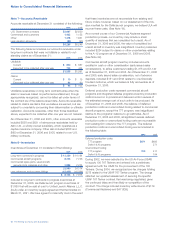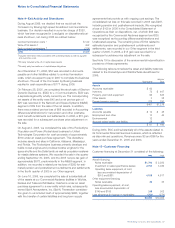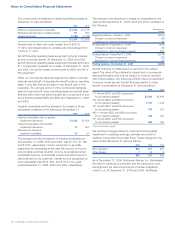Boeing 2006 Annual Report Download - page 50
Download and view the complete annual report
Please find page 50 of the 2006 Boeing annual report below. You can navigate through the pages in the report by either clicking on the pages listed below, or by using the keyword search tool below to find specific information within the annual report.48 The Boeing Company and Subsidiaries
Notes to Consolidated Financial Statements
Fleet Support
We provide the operators of all our commercial airplane models
assistance and services to facilitate efficient and safe aircraft
operation. Collectively known as fleet support services, these
activities and services include flight and maintenance training,
field service support costs, engineering services and technical
data and documents. Fleet support activity begins prior to air-
craft delivery as the customer receives training, manuals and
technical consulting support, and continues throughout the
operational life of the aircraft. Services provided after delivery
include field service support, consulting on maintenance, repair,
and operational issues brought forth by the customer or regula-
tors, updating manuals and engineering data, and the issuance
of service bulletins that impact the entire model’s fleet. Field
service support involves our personnel located at customer
facilities providing and coordinating fleet support activities and
requests. The costs for fleet support are expensed as incurred
as Cost of services.
Research and Development
Research and development (R&D) includes costs incurred
for experimentation, design and testing and are expensed as
incurred unless the costs are related to certain contractual
arrangements. Costs that are incurred pursuant to such
contractual arrangements are recorded over the period that
revenue is recognized, consistent with our contract accounting
policy. We have certain research and development arrange-
ments that meet the requirement for best efforts research and
development accounting. Accordingly, the amounts funded by
the customer are recognized as an offset to our research and
development expense rather than as contract revenues.
We have established cost sharing arrangements with some
suppliers for the 787 program, which have enhanced our
internal development capabilities and have offset a substantial
portion of the financial risk of developing this aircraft. Our cost
sharing arrangements explicitly state that the supplier contribu-
tions are for reimbursements of costs we incur for experimenta-
tion, basic design and testing activities during the development
of the 787. In each arrangement, we retain substantial rights to
the 787 part or component covered by the arrangement. The
amounts received from these cost sharing arrangements are
recorded as a reduction to research and development expenses
since we have no obligation to refund any amounts received per
the arrangements regardless of the outcome of the development
efforts. Specifically, under the terms of each agreement, pay-
ments received from suppliers for their share of the costs are
typically based on milestones and are recognized as earned
when we achieve the milestone events and no ongoing obligation
on our part exists. In the event we receive a milestone payment
prior to the completion of the milestone, the amount will be
classified in Accounts payable and other liabilities until earned.
Share-based Compensation
Our primary types of share-based compensation consist of
Performance Shares, ShareValue Trust distributions, stock
options and other stock unit awards.
In 2005 we adopted the provisions of SFAS No. 123 (Revised
2004), Share-Based Payment (SFAS No. 123R) using the modi-
fied prospective method. Prior to 2005, we used a fair value
based method of accounting for share-based compensation
provided to our employees in accordance with SFAS No. 123.
(See Note 16).
Income Taxes
Provisions for federal, state and non-U.S. income taxes are
calculated on reported Earnings before income taxes based
on current tax law and also include, in the current period, the
cumulative effect of any changes in tax rates from those used
previously in determining deferred tax assets and liabilities.
Such provisions differ from the amounts currently receivable
or payable because certain items of income and expense are
recognized in different time periods for financial reporting
purposes rather than for income tax purposes. Significant
judgment is required in determining income tax provisions and
evaluating tax positions. We establish reserves for income tax
when, despite the belief that our tax positions are fully support-
able, we believe that it is probable that our positions will be
challenged and possibly disallowed by various authorities. The
consolidated tax provision and related accruals include the
impact of such reasonably estimable losses and related interest
and penalties as deemed appropriate. To the extent that the
probable tax outcome of these matters changes, such changes
in estimate will impact the income tax provision in the period in
which such determination is made.
Postretirement Plans
We sponsor various pension plans covering substantially all
employees. We also provide postretirement benefit plans other
than pensions, consisting principally of healthcare coverage to
eligible retirees and qualifying dependents. Benefits under the
pension and other postretirement benefit plans are generally
based on age at retirement and years of service and for some
pension plans, benefits are also based on the employee’s annual
earnings. The net periodic cost of our pension and other post-
retirement plans is determined using the projected unit credit
method and several actuarial assumptions, the most significant
of which are the discount rate, the long-term rate of asset
return, and medical trend (rate of growth for medical costs).
A portion of net periodic pension and other postretirement
income or expense is not recognized in net earnings in the year
incurred because it is allocated to production as product costs,
and reflected in inventory at the end of a reporting period. If
gains and losses, which occur when actual experience differs
from actuarial assumptions, exceed ten percent of the greater
of plan assets or plan liabilities we amortize them over the
average future service period of employees.


